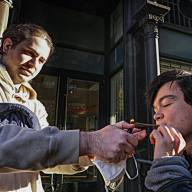SANTIAGO, Chile – Flights to Easter Island, home to the famous gigantic stone heads known as Moais, resumed Monday after weekend protests that blocked the local airport.
The shutdown had stranded about 600 tourists in the capital, Santiago, many of them Europeans with travel packages that include a trip to the remote southern Pacific island.
About 20 protesters occupied the runway and other areas of Easter Island’s Mataveri airport over the weekend to demand greater controls over who can come to the island, saying the increasing population is harming the environment and the mysterious statues.
Easter Island has seen increased tourism as well as migration from foreigners and mainlanders who stay on. It is home to about 2,500 islanders of Polynesian descent – plus about double that number of tourists and “continental” residents who occupy its 60 square miles (160 square kilometres) at any given time.
“We are seeking the establishment of a system of control and permanence for people who come to the island, be they tourists or not,” protesters’ spokesman Rafael Tuki told Cooperativa radio.
The protesters left the airport Monday allowing authorities to resume flights, Interior Department deputy secretary Patricio Rosende told The Associated Press. He said he plans to fly to Easter Island to meet with residents.
“Easter Island’s situation is not the same as an airport located here on the continent,” said Pablo Ortega, secretary-general of the Chilean aviation agency. “A plane that takes off for Easter Island or comes from Tahiti to Easter Island needs to have landing alternatives in case of a problem.”
Mataveri Airport, about 2,360 miles (3,800 kilometres) from the mainland, “must have the security of its operations absolutely guaranteed,” Ortega said.
Also known as Rapa Nui, the island was declared a UNESCO World Heritage site in 1995 for its nearly 600 Moais, which range in weight from 2 to 20 tons.













